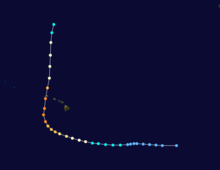Guess what time of year it is! That’s right, it’s hurricane season in Hawaii!
Every year from the beginning of June to the end of November, Hawaii has its eyes on the Pacific Ocean from Mexico to Japan, watching for weather disturbances. The Central Pacific Basin, in which Hawaii squarely sits, is monitored constantly by NOAA (the National Oceanic and Atmospheric Administration.) Our busiest month for hurricanes is usually August, followed by September.
Let’s be real: Hawaii is in a blessed spot. Hurricanes rarely strike us directly, and there are some good scientific reasons for this. First, Hawaii is a small target in a big ocean. The Pacific is the largest and deepest ocean on the planet: it covers about 63 million square miles and contains more than half of the free water on earth. Hawaii is not a large landmass, so right off the bat, a hurricane would have to move just right in order to hit it. Second, Hawaii is protected by the cooler water of the Central Pacific. Hurricanes thrive in warmer waters, so they’re usually generated near the Mexican and Central American coastlines in the shallower water during the summer and early autumn months. As they’re pushed across the Pacific ocean towards the west by prevailing trade winds, they hit the cooler deeper water of the Central Pacific. (Click here to read more about “upwelling” and the process by which ocean temperatures change.) Once they hit that cooler water, these hurricanes become vulnerable to winds coming from other directions that can tear the storm apart. Why? Because the hurricane no longer has access to all of that easy evaporated water it had over warmer ocean waters. The evaporating water is its fuel. This is another reason why hurricanes tend to fall apart quickly once they make landfall. (NatGeo.)
/https://public-media.smithsonianmag.com/filer/9e/f3/9ef31709-5772-47ea-bf5a-23f888c23152/eastpacific_vir_2014217_lrg.jpg)
If a hurricane follows a more southerly path, there’s a better chance of it reaching the islands. For example, Hurricane Iniki came from the south of the islands and swung northward just after it passed beneath us. It was able to keep feeding off of the warmer equatorial waters and maintain its strength.

Most of the time, the cooler waters brought down from Alaska into the Central Pacific kills or weakens any storm that attempts to approach from due east. It’s a fact that “Virtually every system approaching Hawaii from the east since 1950 tracking at least as far north as the latitude of the Big Island of Hawaii eventually weakened to a tropical storm or depression by the time it reached the islands.” (Weather.com.) However, in an El Nino year, the chance of a hurricane tracking within 100 miles of the islands increases by 13%. This is due to El Nino’s effect on ocean water temperatures. Both of Hawaii’s most recent destructive hurricanes (Iniki and Iselle) happened during El Nino years.


Back to reason number 3 why hurricanes rarely hit us directly: wind shear (or hurricane poison, as you could think of it) is usually stronger near the Hawaiian Islands. Wind shear is the rapid change in wind speed and/or direction over a short distance, and the wind shear around Hawaii is usually what takes hurricanes apart. It has also been posited that Mauna Loa and Mauna Kea, the two giant volcanoes dominating the landscape of the Big Island, have an effect on wind circulation when storms attempt to make landfall here. Although they won’t have much effect from a distance, any storm that hits the Big Island directly will probably die a swift death.
It’s probable that due to climate change and the warming of the oceans, Hawaii will begin to see an increased number of storms. One current prediction is an increase of 15% per decade (Forbes.)

However, data is still being collected and only time will tell exactly how many heavy storms Hawaii could see in the future.
Don’t let this slow you down if you’re thinking of visiting! Hawaii is a wonderful place full of beauty and aloha, and big storms are still so rare here that the usual response of locals to dire weather predictions is humorous jokes. The key to hurricane preparedness is to stay informed and pay attention to the NHC.
By S. Garcia
